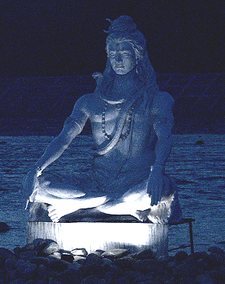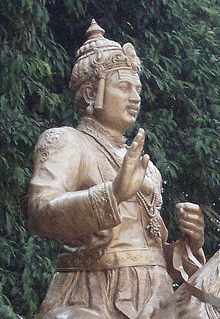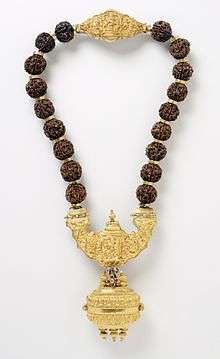Jangam
| Part of a series on |
| Shaivism |
|---|
 |
|
Deities |
|
Scriptures and texts |
|
Practices |
|
Schools
Saiddhantika Non - Saiddhantika
|
|
Related
|
The Jangam or Jangama are a Shaiva order of wandering religious monks.They belong to Veerashaiva Lingayat community. They are the priests or gurus of the Hindu Shaiva.[1] There is an age old tradition calling Jangamas as gurus of'Lingayat’ .Jangamas are disciples of Lord Shiva as mentioned in Puranas. A visit of a jangam to a house is treated as the visit of Lord Shiva himself and the jangam shall be given good alms and the jangam blesses the natives. The Jangam is the wandering holy man in Virashaivism.
History
According to the Hindu mythology of India, Goddess Parvati had claimed that she had given birth to Lord Ganesh (elephant headed Deity) when she died as Sati (previous incarnation who died by self-immolation). She told Lord Shiva. that he too should also create a similar lord. Lord Shiva proceeded to cut his thigh and his blood spilled on the lifeless statue known as Kusha which immediately came alive and was thereafter referred to as Jangam. The term 'Jangam’ (or Jangama or Jangamar or Jangamayya or Jangam Yogi, or Jangam Jogi, or Jangam Guru) is also the name given to the wandering Shivite (Hindu worshippers of Lord Shiva) mendicants who are believed to be descendants of the original ‘Jangam’. They function as priests or Guru for all those who follow the Shivite cult and for those who don’t avail of services of the Brahmin priests. In most temples the priests who conduct the religious rituals are Brahmins however this is not true for the Lord Shiva temples where the Jangams perform the Pooja (prayer and worship of Lord Shiva). The Jangam priests may preside over all rituals however special regard is given to marriage rites in Lingayatism and Shaivism section of Hinduism.

Jangam : Born out of Lord Shiva's Thigh and Religious priestly (by priest, religious prayer, prayer for healing, and Guru): Jangam sages, who claim they originated from a part (thigh) of Lord Shiva's body. Jangam claims that he is born out of the thigh of Shiva. Hindu mythology has it, Shiva wanted to give some donation to Brahma and Vishnu but when they refused he became so angry that it led to his creating the Jangam Sages.. Jangam or Jangama over the generations have been able to maintain a distinct identity over generations. What sets them apart is their attire and the rituals that they follow. The Jangam sages go from one place to another and explain the different saints the story of the holy union of Lord Shiva and Parvati. With the Shivpuran (Lord Shiva) on the tip of their hand, enacting the epic tale for them is nothing but a piece of cake. Hindu mythology has it, Lord Shiva had blessed them with immortality but declared that they would live by religious begging in Lord Shiva temples (by priest, religious prayer, prayer for healing, and Guru ). Another version is that Lord Shiva at his wedding created two recipients of his alms, one Jangam, from the sweat of his brow, the other Lingam, from his thigh. These Jangams accept alms from devout. The jangams meanwhile suggest, they don’t earn more money, a month. They do so by religious Prayer (The chanting of mantras) begging (by priest, religious prayer, prayer for healing, and Guru) in Prayer in Hinduism. At present, The 21st Century, Still now they (some Jangam) follows the Hindu mythology of Jangam ie., according to Hindu mythology Lord Shiva had blessed them (Jangam) with immortality (ie., entire world is destroyed by nature or some other factors to destroyed the nature, Jangam will Live) but declared that they would live by Religious Begging in Lord Shiva temples (by priest, religious prayer, prayer for healing, and Guru) (The Lord's Prayer) after some religious event completed by them in Prayer in Hinduism.
Jangama Dhyana
Jangama dhyana is not related to ancient Veerashaiva/Lingayat jangam sages. For more information visit Jangama dhyana
Jangama dhyana technique is associated with Shri Shivabalayogi Maharaj and his direct disciple Shri Shivarudra Balayogi Maharaj. On 7 August 1949, Shri Shivabalayogi experienced a vision of a tall Jangama Sage (ancient order of ascetics) with matted hair, who told him to sit in padmasana (lotus posture), and close his eyes. The Sage then touched the young boy between the eyebrows and instructed, 'Watch here.' Thus, Shri Shivabalayogi Maharaj sat in tapas (deep, prolonged meditation) for twelve years, meditating for 23 hours a day for eight years and around 12 hours a day for the remaining four years. After this period, he initiated tens of thousands of people into the meditation technique he had used to achieve Self Realization.
The name for the technique was coined by Shri Shivabalayogi while walking around the Dehradun ashram one night with his direct disciple, Seenu, who was later to become the Enlightened Yogi, Shri Shivarudra Balayogi. He suddenly turned to Seenu and said:
"Perhaps it would be nice to name the meditation technique we are teaching worldwide as Jangama dhyana. Lord Shiva first appeared to me in the form of a Jangama Sage to impart the technique, and Jangama means 'Eternal Existence'; so Jangama dhyana would mean 'meditation on the Eternal Existence of the Self."[2] For more information visit Jangama dhyana

Jangam Lingayat or Jangam or Jangama in Tamil Nadu and Puducherry
The Jangam Lingyat called as Jangam Lingayath religion caste is composed of respectable people.Pandaram is surname ( Title) of Jangam people. The name pandaram is from Tamil word means valuable storing place of jewels, navarathnas stored in the Lord Shiva temples and palaces, they are placed to maintain the jewels of Lord Shiva temples and palaces in Tamil Nadu. Jangam Lingyat Pandaram (Jangam Lingyat or Jangam) in Tamil Nadu are Land holders, Traders, Sanyasis or Monk or Priests or Guru and Managers of richly endowed Lord Shiva temples in Tamil Nadu. The Jangam Lingayat pandaram are known as Lingayath religion or Jangam Lingayath or Jangamma in Lord Shiva temples and Lord Basava temples in Tamil Nadu and Puducherry. Many Jangam live in Tamil Nadu, specifically, and in Virudhunagar, Sivakasi, Dindigul, Pattukkottai, Theni, Dharmapuri, Madurai, Krishnagiri, Namakkal, Erode, Tirupur, Villupuram, Arni and Coimbatore, Pudukottai, Salem, Kanchipuram, Thiruvellore, Trichy and Chennai (Madras) districts. In Kerala,specifically Palakkad, Kollam, Kottayam districts.[3] The Jangam is the holy man in Virashaivism. The divinity of the Jangama is reflected in many narrative stories in the Basava Purana and other collections, and in which the Jangama is actually Shiva. Jangam also called as Veerashaiva Brahmins.

Jangam or Jangama Lingayat or Jangam Ayya (the priest hood section of Lingayathism) in Karnataka: Lingayath contains two sections, one the ancient race of Veerashaiva jangam ( the priests at Srisailam and Kedarnath since the times of Adi Shankaracharya) and the Lingayat which constitutes all different working classes of the society. Jangam Lingayaths were Ishtalinga on their chest hanging through a thread in Karnataka. After death they are buried in Dhyana-Mudra with Linga in hand or they have given Samadhi or called Lingaekya or merger in god Linga. They believe in formless god in form of Ista-Linga and no other idol . The Jangam Lingayat or Jangam are known as Lingayath or True Lingayath or Movable Lingam or Jangam Sage or Jangama or Lingayat Priest or Jangam Guru or Guru/ Jangam Ayya in Lord Basava Period of Lingayath Religion and Lord Shiva temples in Karnataka.
Jangam Jogi or Jangam: From the Region of Haryana
Jangam Jogi are folk musicians associated with region of Haryana. Jangam is a style of devotional music dedicated to Lord Shiva by Jangam community from Haryana. Their instruments are small and portable (being travellers) like dafli, khanjari, khartal. Jangam Gāyan: Devotional Music and Folk Music of India: Jangam Gāyan is a narrative sung by the Jangam and is performed in the temple courtyards of Lord Shiva temples to huge gatherings. Sometimes, there are public performances in village squares. The members of this community are wandering mendicants and earn their living mainly by performing the element in Lord Shiva temples. The Jangams are also live in Shiva the state of Haryana in India. The community is concentrated in and around Kurukshetra, the great battle field of the epic of Mahabharata and in the historical town of Thaneswar which has been a strong centre of the Pasupati (Lord Shiva) tradition of Shaivism. Besides, they also move as itinerant religious mendicants in the adjoining states of Punjab, Rajasthan, Uttar Pradesh, Uttaranchal, Himachal Pradesh and Jammu and Kashmir in north India.
Jangam or Jangam Deva or Jangamayya in Andhra Pradesh and Telangana
At present, Jangam follows the Hindu mythology of Jangam i.e., according to Hindu mythology of Lord Shiva they would live by Religious priestly performance (by priest, religious prayer, prayer for healing, and Guru). Jangam Katha: Folk Dance in Andhra Pradesh: Jangam Katha is a special folk dance of the Andhra Pradesh state. Jangam Katha, is a special Dance of Andhra Pradesh Jangam or Jangam Deva or Jangamayya and it observes tales from the Indian Hindu Mythology. In the performance, the main artist (Jangam or Jangam Deva or Jangamayya) narrates a story, plays music and dance on the tunes. The co-artists beat drums and speak to him, enriching certain events in the story.
Jangam or Jangama is one who is endowed with the true knowledge, sacrificed his life for the society, and avoided all the worldly happiness and attained the divine happiness. Jangam, a Sanskrit word, etymologically means that which moves. When this word applied to a person, in the context of Lingayath religion, it symbolizes a man who moves from place to place preaching moral and religious values in Shaivism, Lingayatism and Jangama dhyana section of Hinduism. The two main categories of Jangam are 1) Sthira 2) Chara. Sthira Jangama: is a person who, staying in math (mutt) i.e., a Lingayath monastery, has to carry on mass education, preaching to the local people, and giving them the necessary guidance to achieve spiritual progress called Jangama dhyana, and to perform certain rites and rituals concerned with birth, marriage, death, holy communication on special occasions etc. Chara Jangama is one who constantly moves around, preaching as he goes, without settling himself at any particular place and without accumulating any property of his own.
Jangam Dance, Indian Folk Dance
Jangam Dance is an Indian folk dance performed in the honour of Lord Shiva in Lord Shiva temples. Those who perform this traditional dance are called Jangam dancers. The term Jangam has been derived from the movable emblem of Lord Shiva. Jangam is a sub-caste of the Lingayat (Veerashaiva) community called Lingayath religion. The Jangams migrated from Karnataka and Andra Pradesh states of India in order to disseminate the Shaivaite cult and to act as priests for those who do not avail the services of Brahmans for performing religious rites in Lord Shiva temples. While performing Jangam dance, the dancers recite verses on the mythological marriage of Siva and Parvati. The recitation is done in a ritualistic hypnotic monotone. As performers, they entertain people during religious and social festivals in the obscurity of the villages. Their dramatic presence is heightened by their headgear, a brass band with the image of a snake and peacock feathers flashing in the air. Their narrative and rhythmic movement is embellished by bells, gongs, manjim or cymbals, and chhenna or percussion sticks, weaving the most incredible musical patterns. Presently, forced into penury by the loss of rural audiences to mass media, they are reduced to begging for alms.
Historical background of Jangam Math in Nepal
In the 9th century, the king Narendra Dev of Lichhivi dynasty has described the Jangam Pratishthan, which is available in stone inscription in Anantlingeshwor temple, in which he has addressed the name of the Chancellor of Jangam Pratisthan and explained rights and duties performed by the Pratisthan. With this evidence we can say that Jangam community was present in Nepal before the 9th century. The king of Karnatvansh Shri Nanya Dev became ruler of Mithila state (Northern Bihar) by expanding his dynasty in the 11th century. During the period Veerashaiva Jangam were the Rajaguru of the King Nanya Dev. After ruling the Mithila dynasty for 240 years King Harisingh Dev Mall became the king of Nepal Mandal and established the capital at Bhaktapur City. Devi Tula Bhavani was the deity they worshiped and they started spreading the religion of veerashaivism in the region. When Malla Vansh (dynasty) was established in Nepal Mandal Veerashaiva religion had started. The veerashaiva philosophy was being popularized by the disciples. It establishes that Veerashaiva religion section of Hinduism had its roots since the 9th century. There is a Jangam math in Bhaktapur. There is a stone inscription belonging to Nepali Year 692, which explains the role of Hari Singh Dev Mall of mallavansa, who renovated the Jangam math in Bhaktapur. With this, we can say that Veerashiava Religion was established in Nepal in the 13th century. There are many Stone writings and Tamrapatra available in jangam math in Nepal. Jangamwadi Math, Jangambari, Varanasi, Uttar Pradesh: Jangamwadi Math is the oldest Math among all the maths of Kashi, Kashi Vishwanath Temple Uttar Pradesh, India and is also known as Jnana Simhasana or Jnana Peetha. Jangam means knower of Shiva, wadi means living place. One among the five of the holiest shrines for the Lingayath religion.
See also
References
- ↑ Russell, R. V.; Lal, Hira (1995). The tribes and castes of the central provinces of India, Volume 1. Asian Educational Services. p. 222. ISBN 81-206-0833-X.
- ↑ Bruce Young, 2008, Guru-Disciple, p. 190.
- ↑ Reddy, S. S. (2004). "Jangam". In Singh, Kumar Suresh; Bhanu, B. V.; Anthropological Survey of India. People of India: Maharashtra. Popular Prakashan. pp. 830–838. ISBN 81-7991-101-2.
External links
- Lingayat's Unique Symbol for Alimighty, Supreme GOD - Lingam and Jangam Guru
- Overview Of World Religions (http://www.philtar.ac.uk)
- UNESCO -Intangible Cultural Heritage UNESCO- Jangam (https://ich.unesco.org/en/state/india-IN)
- Jangam Devotional Music
- Jangama Dhyana
- Intangible Cultural Heritage - Jangam Gayan (http://ignca.nic.in)
- Jangam Nepal
- Intangible Cultural Heritage - Jangam (http://sangeetnatak.gov.in)
- Vira Saivism: Jangam or Jangama (http://www.saivism.net)
- Jangam Jogi (http://www.visionias.in)